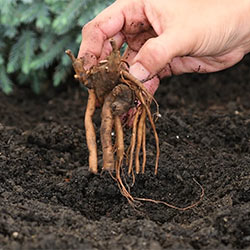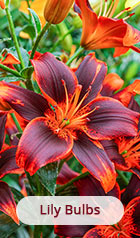Thank You!
We have received your request. You will be notified when this product is in stock.
X
This tuberous perennial comes in a variety of stunning colors. Our selection of begonia plants for sale includes double bloom begonias, picotee begonias and fragrant begonias as well as solid color and mixed varieties. Buy begonia bulbs for sale today!
How to grow begonias:
Growing begonias begins with determining a location to grow them, which is surprisingly easy. Our hardy begonias will thrive nearly everywhere. Begonia tubers can be planted in shade or partial shade: as long as they aren't placed in direct sunlight, begonias will be happy. Begonias love fertile, well drained, humus rich soil, so amend the partial-shade spots in your garden, or plant your begonias in your favorite planter or hanging basket! Begonias should be spaced about one foot apart in the garden, but can tolerate slightly closer quarters in a container.
Once planted, keep your begonias fed and hydrated. Fertilize your begonia plants at the base monthly, using a balanced fertilizer such as a 20-20-20 mix. Liquid fertilizer makes feeding your plants easier -- for you and for the begonias. Water the soil around the base of your plants, but don't get the foliage wet. Begonias like their soil to be moist, but never waterlogged.
Begonias do not require deadheading, however doing so every few days encourages new stems to grow. Pinching off some of the single blooms encourages more growth of full, double flowers. In the fall, you'll need to lift your begonias.
At the end of the growing season you can overwinter your begonias by either storing the pots indoors or by lifting the tubers, curing them and then storing in a cool, dry location.
When should begonia bulbs be planted?
Let's first talk about warmth: begonias are only truly hardy in southern growing zones. In other zones, they should be lifted in autumn, and replanted in spring. Plant your begonias after the threat of frost has passed, or start them indoors and transfer them to their growing location after the last frost date.
Do begonias come back every year?
Are begonia plants annuals or perennials? Semperflorens varieties, such as the wax begonias or bedding begonias you can buy at the local nursery each spring, are annuals. Hardy begonias are perennials: but they do need a bit of care to come back year after year. In Zones 9 and 10, begonias can thrive outdoors all year round. In cooler climates, begonias won't survive the cold to return the next spring and will need to be overwintered, or lifted and replanted in the spring.
If you'd like to leave your begonias in pots through the winter, simply bring them indoors as the temperatures drop into the mid-40s, and make sure to provide adequate watering and humidity. You can simply treat your begonias as houseplants, and keep them warm and well-watered until spring!
You can also save your begonia tubers over the winter and re-plant in the spring. To lift begonia bulbs, dig up your begonias and their tubers after the first frost has killed off their tops and the leaves have yellowed. Cut back the foliage, leaving a little soil on the fibrous roots. Then, cure your tubers by allowing them to rest in a warm, dry location out of direct sunlight. The curing process takes about one week. The tubers can now be stored between layers of paper in a room with a temperature above freezing but below 60 degrees Fahrenheit. In late winter or early spring, repot your tubers indoors, or wait until after the last frost and plant them outside!
Can I leave my begonias in pots over winter?
In most zones, begonia tubers can be overwintered right in their pots. In the fall, simply bring your begonias inside -- they make happy houseplants. Make sure to water your begonias regularly, and consider adding a humidifier to your home. Begonias can suffer from crispy edges when not provided with a properly "tropical" humidity level, and household heat can dry out the air. You can also set a pebble tray near your begonias to allow water to evaporate into the air.
How do you keep begonias blooming?
The key to a bountiful begonia bloom: fertilization and deadheading. Use a balanced fertilizer (such as a 10-10-10 or 20-20-20 formula) on your in-ground begonias every month during the blooming season, and fertilize potted begonias once every two weeks. Pinching back faded blooms (deadheading) encourages new stems and flowers to form. If you pinch back blooms that appear on a double begonia you will encourage more double blooms.
Should I deadhead begonias?
Do you really need to deadhead begonia flowers? No, old flowers will drop off as new ones appear, but you should consider deadheading your begonias to keep them clean and encourage new blooms. Wilted flowers look unsightly, and can retain moisture and fungus or other plant disease. To deadhead these plants, check for faded and spent flowers every few days. When you find a stem with a faded flower, grab the stem about one-half of an inch down from the flower. Pinch the stem to snap the flower off. Deadhead regularly to clean up your begonias and prevent rot.






















